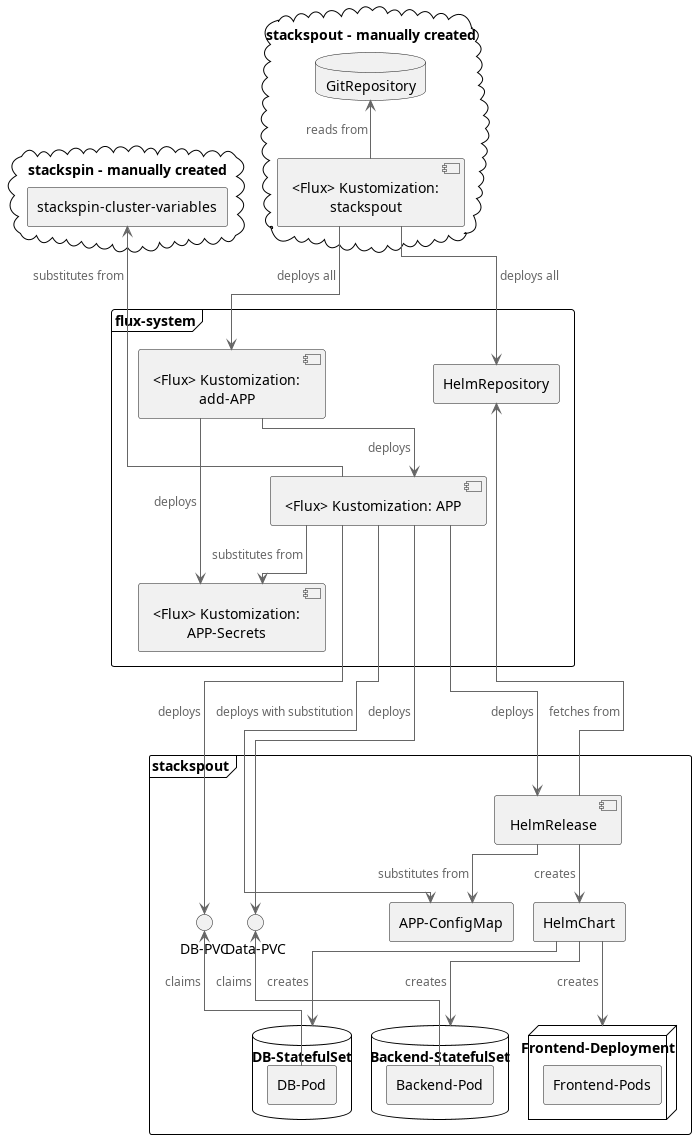| apps | ||
| infrastructure | ||
| overrides | ||
| .gitignore | ||
| adopt-secrets.sh | ||
| install.sh | ||
| README.md | ||
| stackspin-local-path-provisioner-override.yaml | ||
| stackspout.png | ||
Stackspin Outwards - Stackspout
This repository extends Stackspin with extra applications and overrides focused on business use. Once stabilized, the aim is to contribute as much upstream as possible.
Stackspout is used in day-to-day business with a double-digit user number, so all experiments happen carefully. Still, it is an experimental offering.
Tools
Useful tools for administration:
- my
stackCLI helper, currently part of my dotfiles: https://git.jfischer.org/xeruf/dotfiles/src/branch/main/.config/shell/server#L11 - stackspin docs: https://docs.stackspin.net/en/v2/system_administration/customizing.html
Explanation - Typical App Deployment in Stackspout with Flux on Kubernetes
The diagram illustrates generically how continuous app deployment works in our Kubernetes cluster from Infrastructure-as-Code using flux. Not every app has database, backend and frontend, but in the end the deployments all work very similarly so there is no point showing it for each individual app. Except for the Single-Sign On, apps also do not really depend on each other.
Explanations:
- deploy :: creates a resource on the cluster from a file in the GitRepository
- create :: creates a resource on the cluster using Kubernetes logic
- ... all :: creates multiple independent resources
All Flux Kustomizations refer to a directory in the GitRepository, but for clarity I omitted it beyond the initial one.
Clouds are created not via Flux GitOps, but through one-time scripts.
Guide: Creating OAuth Credentials for an external service
-
push an OAuth2Client definition like for the apps, adjusting
metadata.nameandspec.secretNameas well asspec.redirectUris -
obtain the generated
client_secretfor your application from kubernetes:kubectl get secret -n flux-system stackspin-APP-oauth-variables --template '{{.data.client_secret}}' | base64 -dwith client_id:
kubectl get secret -n flux-system stackspin-APP-oauth-variables --template '{{.data.client_id}}{{"\n"}}{{.data.client_secret}}{{"\n"}}' | while read in; do echo $in | base64 -d; echo; done
Customizations
Overrides
- Adds many Nextcloud extensions and some configuration
-> most notably
externalto add Applications into Nextcloud as hub
New Applications
below list is formatted as:
subdomain: Service (helmrepo, if not provided by the service authors)
Stable including Single-Sign-On
- forge: Forgejo
- do: Vikunja
No SSO
- ninja: InvoiceNinja
- support: Zammad
- flow: n8n (8gears)
- meet: cal.com (pyrrha)
- status: Gatus (minicloudlabs)
Planned
- design: penpot (truecharts, waiting on PR)
- sprint: taiga (nemonik)
- video: Peertube (LecygneNoir )
- call: Jitsi Meet / OpenTalk
- wiki: Wiki (maybe wikijs, but I'd like something that integrated with Nextcloud and Markdown/Orgdown)
Ideas
- link: URL Shortener
- connect: Bonfire
Stale
- people: SuiteCRM (bitnami repo)
- time: Kimai (robjuz repo)
Functionally
- Nextcloud too slow - add Redis?
- Preconfigure user settings in Nextcloud, Vikunja and more
Setup
Warning: Lots of experiments happening here!
First install Stackspin. Then apply the configuration to your cluster:
install.sh
Done! Note that the added applications are currently only toggled via repository changes and integration with Stackspin mechanisms is very rudimentary. To list the central resource related to this repo:
kubectl get gitrepositories -A
kubectl get kustomization -A -o=jsonpath='{.items[?(@.spec.sourceRef.name=="stackspout")].metadata.name}'
kubectl -n stackspout get helmreleases
kubectl -n stackspout get pods
But there are also ConfigMaps, Secrets, StatefulSets, PVCs, Helmrepos and more...
